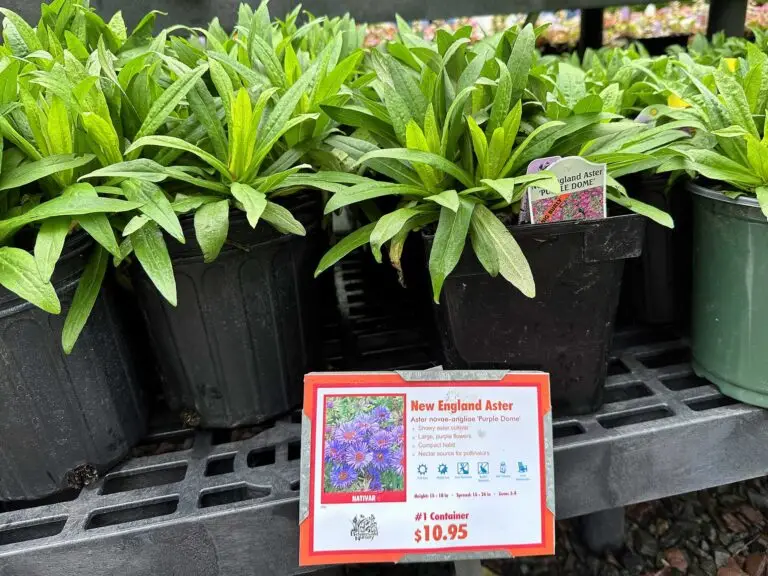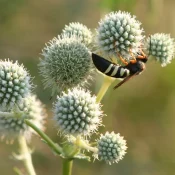Do I need to know Latin plant names?
No—you don’t need to memorize Latin to get into native plant gardening. Having a Latin plant name is helpful when you’re looking for a specific plant, but it’s not a requirement. You can always look it up with a quick Google search or in our Plant Profile Library.
Latin names simply make plant identification error-free, because every plant has only one. Once you understand the gist, it’s actually pretty simple. (And don’t worry about pronunciation—scroll on to find out why.)

Common Names vs. Latin Names
Like most people in America, every native plant has a few different names. These fall into two main categories:
- Common name: A plant’s nickname, often describing how it looks or behaves.
- Latin name: A plant’s official, unchanging first and last name.
Let’s dig into both and build some confidence in when (and why) Latin names can come in handy.
First up: Common Name
What is a common name?
A common name is simply a nickname.
Some common name/nickname examples:
- Echinacea → coneflower
- Monarda didyma → bee balm or bergamot
- Dwayne Johnson → The Rock
Where do common names for plants come from?
Common names are often inherited from generations past and usually describe a feature or behavior:
- Buffalo grass is a native prairie grass; the name itself conjures up herds of buffalo munching the grass alongside Native Americans for thousands of years
- Ninebark’s common name refers to its unique bark, which peels back to reveal layers as it ages
- Milkweed gets its common name from its sap, which is (mostly) milky white
- Obedient plant has flowers you can bend, so previous generations decided to call it ‘obedient’
The problem with common names
One plant can have many nicknames—and they can change by region or culture. For example:
These are all nicknames for the same tree:
Flowering Ash
Old-man’s-beard
Granddaddy Graybeard
Grancy Gray-beard
Fringe Tree
To ensure you’re buying a Grancy Gray-beard at a native plant nursery, look for the Latin name Chionanthus virginicus.
This nickname confusion is why every plant has just one Latin name.
Why Latin names exist
Every plant has a single Latin name, written in two words: Genus species.
This system is called binomial nomenclature and was introduced in 1753 by Carl Linnaeus. It sounds intimidating, but it’s really just a two-word version of our first-name-last-name system, backwards.
Latin name = Genus Species (Just two words! Not so scary.)
Every plant has a botanical name in Latin that is usually shortened to two words:
- Genus: The broader group a plant belongs to—like a shared last name among relatives.
- Species: The specific plant within that group. This can also be called a plant’s “specific epithet.”
If we binomially nomenclature-d people, we’d know
- Knowles Béyonce
- Johnson Dwayne
- Reeves Keanu
The cool thing about understanding how Latin naming works is that you can quickly see plant families’ similarities and differences. For instance:
Introducing…the Lobelia genus
Lobelia cardinalis
Lobelia siphilica
Both of these Lobelias are super yummy plants for hummingbirds and butterflies; you can see at a glance how their tall, flower-filled stalks are similar, making them cousins in the Lobelia genus.
The crazy thing is that the Lobelia genus has 414 plants in it! No one could remember the names of 414 cousins, so you don’t have to either.
However…
Latin names are useful for finding that one very specific plant
Let’s say you’re visiting a friend’s garden, and you spot it: the most beautiful plant you’ve ever seen in your life.
It has a shape that stops you in your tracks. The flowers connect with your soul and you know: you must grow this plant. You ask your friend what it’s called, and they tell you it’s false dragonhead. You both laugh about how it must come from Game of Thrones (you joke about calling it “Khalesi flower”) as you take a picture, excited to go to the plant nursery and get your own.
At the plant nursery, you ask if they have false dragonheads. The staff member shakes their head, perplexed. They walk you over to snapdragons, saying this is the closest thing they have.
If you knew the Latin name, you’d be able to ensure you’d found the specific plant you’re looking for. Turns out, the false dragonhead (which also goes by the common name ‘obedient plant‘) has the Latin name Physostegia virginiana. The Latin name would ensure you found the plant you wanted.
How do I say Latin names out loud?
Don’t be intimidated! Botanical Latin is a written language “without a consistent pronunciation system.” This means that whatever you think it should sound like is right!
Who comes up with botanical Latin names? For hundreds of years, botanists and scientists did. Now, the International Botanical Congress decides on many things, including Latin plant names. They meet every six years to discuss.
How do you find a plant’s Latin name?
If you’re looking for a very specific plant, do a quick online search of its common name to find its Latin name. You can also explore our native plant profiles, which include the Latin names of all our featured plants. Save your favorites via a screenshot or save them to Notes.
Every plant at a nursery or plant sale includes the Latin name on the plant tag. Now, whenever you’re at a nursery or plant sale, you’ve got your list to look for. You’ll be certain of plant identification if you use its Latin name.
In conclusion, just like you don’t worry about remembering the names of your cousin’s in-laws, don’t worry about Latin names
Latin names are great for finding specific plants and seeing how plants are related. Knowing a few of your favorite genus or species names is fun, but don’t feel the need to make flashcards. And now you know how easy it is to understand the basic genus-species system.
Want to build on this knowledge with a little more plant nerdery? Learn about cultivars. Or how about hating on some invasive species? Or go hang out with some lovely native plant experts in our interviews. Happy planting!
















